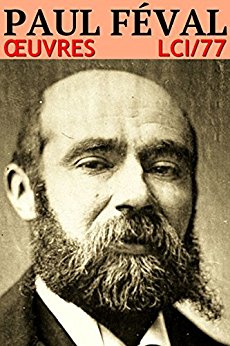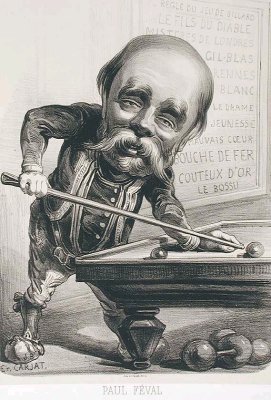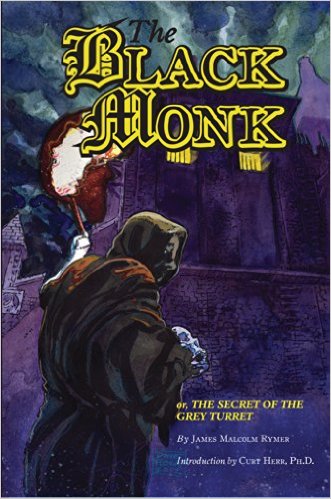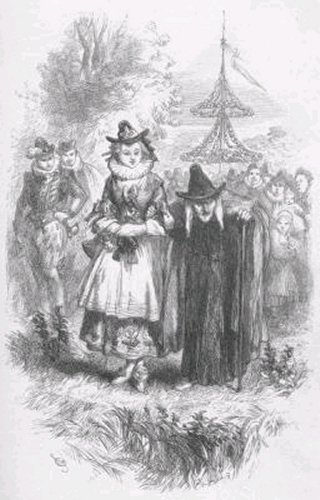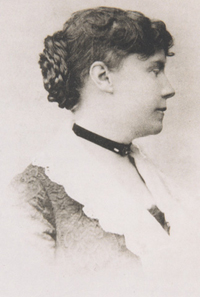This blog might well be titled, “Charlotte Smith, where have you been all my life?” because Smith was a major influence on the development of the early novel, and yet I only just discovered Charlotte Turner Smith (1749-1806) about a year ago when my friend Ellen Moody began blogging about her. Then I began to wonder why I had never heard of her. She was a poet much respected by the Romantics—in fact, she was a distant relative by marriage of Wordsworth and gave him letters of introduction when he went to France. She also wrote ten novels that were very popular and influential in their day. She wrote them all between 1788 and 1798. The first, Emmeline, or the Orphan of the Castle, was a bit immature in style and structure, but it set the tone for much of her later work. The plot concerns an orphan, the believed illegitimate daughter of a nobleman, who, to make a long story short, discovers she is the legitimate daughter of her father and therefore the rightful heir to the castle, despite the manipulations of a rather sinister uncle. Emmeline also has a series of troublesome suitors before she marries the man she loves. I couldn’t help but be reminded of Radcliffe when I read it—the sinister uncle, the illegitimacy, all feel very Gothic, although it is not a Gothic novel.

Charlotte Smith’s second novel, Ethelinde, has just been released by Valancourt Books as a critical edition with an introduction by Ellen Moody.
Then I read Smith’s second novel, Ethelinde, or The Recluse of the Lake (1789). By her second novel, Smith had matured into an accomplished novelist. The novel has just been released for the first time in a critical edition by Valancourt Books, complete with an introduction and notes by Ellen Moody. Upon reading this book, I could well see why Moody feels such enthusiasm for Smith.
Moody had previously told me that Smith uses Gothic elements in her novels, although none of the novels can be rightly termed Gothic. I would certainly not consider Ethelinde to be Gothic, but there are some Gothic elements in it, and Moody says that it was an influential novel upon Ann Radcliffe and Jane Austen, which I can well believe. In her introduction, Moody draws parallels between the novel and Austen’s Mansfield Park specifically.
When I read Ethelinde, I really felt like it was a bridge between the earlier eighteenth century novelists and Radcliffe and Austen. There is much in the novel that owes a debt to earlier sentimental or sensibility novels and the novel of manners. At one point, Ethelinde is in danger of being raped, a clear nod to Richardson’s Clarissa (1748). Ethelinde is also subjected to a host of disagreeable relatives, which reminded me a great deal of Fanny Burney’s Evelina (1778). In Evelina, the title character is more or less persecuted by her middle class relatives who lack genteel manners. In this novel, Ethelinde has both middle class and wealthy relatives, none of whom are quite as comical as in Evelina, but who still have comical elements and some of them are far more cruel in their snobbery and putting on airs once Ethelinde finds herself largely without a protector and penniless.
But what most interested me about this novel was how it is a precursor to Romanticism and Radcliffean Gothic. The Romantic Movement is usually dated from 1798 when Wordsworth and Coleridge published The Lyrical Ballads, but there is much in Smith that shows Romanticism was already alive a decade earlier. Ethelinde opens at Grasmere Castle, a fictional castle in the Lake District. It was so popular with readers that many went to the Lake District and came away disappointed that it wasn’t real. It’s possible that the depiction of the castle inspired Wordsworth later to settle in Grasmere. Both Wordsworth and Coleridge were admirers of Smith’s poetry as well, which often focused on nature.
Ethelinde is at the castle with a pleasure party that includes her cousin, Lady Newenden, and her husband Sir Edward Newenden. The first volume of this five-volume novel takes place at the castle and concerns Ethelinde enjoying nature while also being courted by some disagreeable young, rich men who are friends of her relatives. Eventually, she meets a young man, Montgomery, who seems to be at one with nature and develops a connection with him, especially after he saves her from drowning while all the other men stand and watch or yell at the servants to save her. Montgomery is the character whom I believe is referred to in the subtitle as the recluse. He and his mother live humbly and isolated in Grasmere, but they are of genteel blood. Ethelinde is immediately taken with Montgomery, who at first seems like a character right out of Wordsworth.
The attention to nature in this first volume of the novel also predates Radcliffe’s focus on nature in her novels. In Radcliffe’s The Mysteries of Udolpho (1794), Emily St. Aubert is constantly admiring the beauty of nature and feeling how it calms the soul. By comparison, the villains in the novel, especially Montoni, do not notice nature or see it as a solace or inspiration to the soul. In Ethelinde, the title character enjoys nature, while her obnoxious cousin, Lady Newenden, can find no pleasure in it, constantly complaining she is cold or hot when she is outdoors and fretting over her health—often for attention. Lady Newenden quickly becomes one of the villains of the novel when it is revealed she is likely to or already cheating on her husband. Before the novel is over, Sir Edward will separate from his wife; he will also be accused by her parents of being the adulterer because it becomes obvious that he has feelings for Ethelinde. While in time Sir Edward admits to such feelings, Ethelinde remains true to her love for Montgomery.
Another significant theme in the novel is that of illegitimacy. Smith had already played with this theme in Emmeline, and it was a common theme in earlier novels such as Evelina. Smith, however, does not make illegitimacy so shocking or detrimental as does Burney. In Evelina, the heroine is concerned that her father will not recognize her as his legitimate daughter. In Ethelinde, while Ethelinde is clearly legitimate, many of the supporting cast of characters are not, including Mrs. Montgomery’s brothers and her niece. Nor is illegitimacy something that leads to Gothic situations of incest as in Radcliffe where it nearly leads to a marquis raping his niece in The Romance of the Forest (1791). In her book Art of Darkness, the critic Ann Williams remarks, “Gothic plots are family plots; Gothic romance is family.” The same is true in Ethelinde, minus the Gothic elements. There are twists and turns and surprises along the way for the relatives, most notably when Montgomery’s illegitimate cousin ends up being married to Ethelinde’s brother, Harry Chesterville.
Smith, although focusing on a female main character, and therefore writing what could be considered feminine Gothic, if the book were truly Gothic, also plants the seeds for the masculine Gothic in two of her characters, Harry Chesterville and Sir Edward Newenden. In masculine Gothic novels, such as Matthew Lewis’ The Monk (1795), William Godwin’s St. Leon (1799), and Charles Maturin’s Melmoth the Wanderer (1820), the male characters are often tormented by guilt over their past crimes, by how their poor decisions destroy their families, and by longing for what they cannot obtain. In the novel, gambling, which will be a major transgression in Gothic literature (see Chapter 4 of my book The Gothic Wanderer), leads to the destruction of Ethelinde’s family’s wealth. Her father cannot control his gambling and thus loses most of the family fortune. Then her brother goes on spending sprees that ultimately bankrupt them. While Ethelinde’s father, Colonel Chesterville, feels great guilt over what he has done and fears for Ethelinde’s wellbeing as a result, it is her brother, Harry Chesterville, who becomes the true Gothic wanderer figure who commits transgression through his inability to curb his spending. He ends up in debtor’s prison, leading to his father’s worries turning into illness and his eventual demise. Harry is tormented, describing himself as the “murderer” of his own father. At one point, he becomes so consumed with guilt that he attempts suicide. Harry is like other men in Gothic fiction who seem unable to stop their addictions—fortunately, he is Ethelinde’s brother and not lover. Radcliffe would allow Emily St. Aubert, her Gothic heroine, to marry Valancourt, who also falls into the gambling transgression in The Mysteries of Udolpho, although Valancourt is, thankfully, not a villain and has all the attractions, initially, of Montgomery in his love for nature.

Charlotte Smith, whose own life with an abusive husband she had to leave, causing her to turn to her pen to support herself and her children, included many autobiographical elements into her novels.
While Ethelinde will love and eventually marry Montgomery, his forest god appeal wears off as the novel continues and he is seen as a bit more one-dimensional. The really interesting male in the novel, who also is a forefather to the masculine Gothic wanderer figure, is Sir Edward Newenden. In her introduction to the novel, Moody compares Sir Edward to Sidney Carton in A Tale of Two Cities (1859), who is tormented by love for the woman he cannot have. In the end, Sir Edward is in the same situation, loving Ethelinde, torn between his love for her and social proprieties that make him try to work things out with his wife. When Lady Newenden dies and Sir Edward is finally free to marry Ethelinde—she believes Montgomery has died at sea at this point—Montgomery dramatically reappears and Sir Edward is forced to step aside to see another man marry the woman he loves. Actually, even if Montgomery hadn’t reappeared, Ethelinde makes it clear that her love for Montgomery would make it impossible for her to marry Sir Edward.
Sir Edward is interesting because he is mentally tormented, but not quite a transgressor. I would argue that he did commit a transgression in marrying Lady Newenden for her money, but we are definitely intended to sympathize with him. He is also an early version of several other characters who haunt the pages of near-contemporary novels because they cannot have the love they desire. Interestingly, those characters are usually women. In Maria Edgeworth’s Belinda (1800), Harriet Freke cannot have the man she loves because she is too outspoken and even crossdresses—her last name is no accident—women who are not feminine are freaks. In Burney’s The Wanderer (1814), the outspoken Elinor, believed to be a portrait of Mary Wollstonecraft, also fails to obtain the hero’s love. Both women are examples of transgressing against the patriarchal code while the true heroines of the novels are sufficiently feminine and well-bred enough to know their place in society. Sir Edward, by being a divorced man and having married for money, has also transgressed against society and morality, and therefore, is not worthy of winning the heroine’s hand.
Finally, I would add that the novel has many interesting references to the colonies. Many of the male characters go to the colonies to seek their fortunes. While Smith does not overtly speak out against the exploitation that occurs because of the colonies, they are, to some extent, depicted as dangerous or immoral places. It is in the West Indies that Mrs. Montgomery’s brother, Harcourt, ends up having an illegitimate daughter (not that that can’t happen in England, but it is a sign that morals are lessened in the colonies), and Montgomery nearly dies when returning to England from India. Later novelists would be more brutal in the threat the colonies pose to morality in England—especially the Bronte sisters in Jane Eyre (1847), Wuthering Heights (1847), and Villette (1853), H. Rider Haggard in She (1886), and Bram Stoker in Dracula (1897).
In short, Ethelinde and Charlotte Smith played a central role in the development of the novel of manners, the Gothic, and Romanticism. I would refer people to Moody’s introduction for more about Smith’s influence on Jane Austen. Certainly, Ethelinde has been neglected for far too long. It is a missing link between Richardson, Burney, and Radcliffe. I highly recommend it to anyone interested in Romanticism, the Gothic, and the development of the novel.
You can purchase the new edition of Ethelinde from Valancourt Books at or at most online or local bookstores.
__________________________________________________
Tyler Tichelaar, Ph.D., is the author of The Children of Arthur series, beginning with Arthur’s Legacy and including Lilith’s Love which is largely a sequel to Dracula. His scholarly nonfiction works include King Arthur’s Children: A Study in Fiction and Tradition and The Gothic Wanderer: From Transgression to Redemption. You can learn more about him at www.GothicWanderer.com and www.ChildrenofArthur.com.




